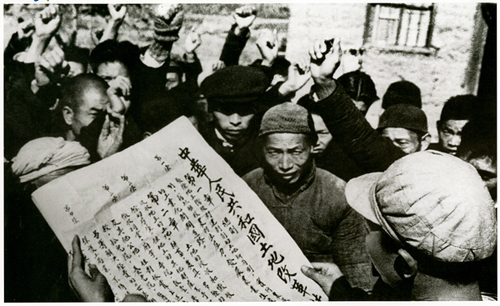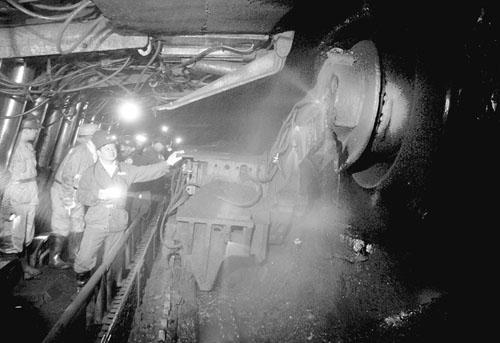Why and How the CPC Works in China
 0 Comment(s)
0 Comment(s) Print
Print E-mail
China.org.cn, June 30, 2011
E-mail
China.org.cn, June 30, 2011
Land reform and economic development
As early as July 14, 1919, Mao Zedong wrote in the first issue of the Xiangjiang Review, a weekly started by him to promote new ideas: "What is the world's biggest problem? It is doubtless the problem of food." The solution to this problem lay in agriculture, the recovery of which was the basis for recovery in all sectors. If there was no food to eat, everything else would be out of the question. The recovery of agriculture could not be brought about without the support of the peasants and land reform in the rural areas.
After the autumn harvest of 1950, the land reform movement led by the CPC was launched by stages and in batches in the newly liberated areas. Up to the winter of 1952 and the spring of 1953, land reform had been completed as scheduled in these areas which had more than 300 million people, except Xinjiang, Tibet and other ethnic-minority areas. The peasants who had gained economic benefits said joyfully that previously they had had the landlord's sky over their heads and the landlord's earth under their feet, but now both had become their own.
After the land reform, the peasants' enthusiasm for production bubbled up unprecedentedly, and an atmosphere of prosperity appeared everywhere in the rural areas. Large tracts of land that had lain waste because of the war were reclaimed.
Take the total sown area in East China for example: In 1952, when the land reform had been basically completed, it had increased by nearly twice as much as that before the Anti-Japanese War (1937-1945). Accordingly, major agricultural produce increased significantly, and the life of the peasants was significantly improved. With the increased purchasing power of rural people, exchange of urban and rural goods was promoted; circulation of commodities was expanded; and market prosperity was promoted. All this played a vital role in the recovery and development of the national economy.
While conducting the land reform in rural areas, the CPC also carried out reforms in the cities, among which the most important were the democratic reform and production reform conducted in state-owned industrial, mining and transportation enterprises.
In old China's industrial and mining enterprises there had generally existed feudal gang-master systems. At the beginning of the founding of the country, in order not to disrupt the existing manufacturing sectors, and to facilitate their takeover, the CPC took a hands-off approach, which was necessary at that time, toward the feudal forces of the industrial and mining enterprises. But with the gradual establishment of the state economy, in order to give full play to the workers' role of ownership of the enterprises, based on going all out to mobilize the masses, the CPC carried out systematic, organized and relatively thorough democratic reforms in the enterprises.
On March 31, 1950 the Government Administration Council discussed and approved a decision on abolition of the feudal gang-master systems in the transportation industry. Similar systems were also abolished in succession in the coal-mining, textiles and other industrial enterprises. At the same time, democratization of management and establishment of factory committees were implemented in state-owned enterprises to enable workers to participate in management, and a group of experienced workers was also promoted to administrative and responsible positions in production.
On the basis of democratic reform and in order to solve the problem of scientific management of enterprises, the CPC also conducted reforms to improve enterprise management, and implement a scientific division of labor, and a rational wage system. Campaigns were organized to promote production competition. Democratic reform and production reform in state-owned enterprises greatly enhanced and strengthened the workers' enthusiasm, labor attitude and sense of ownership.
Building water-conservancy projects and improving transportation conditions were the basis for the restoring of industrial and agricultural production. China was a country vulnerable to flood disasters, and in modern times the Chinese people had suffered both from severe floods and war. The establishment of New China ended the chaos caused by war, but the problem of flooding was still very serious.
To this end, in 1950 the CPC threw itself into the harnessing of the flood-prone Huaihe River. Then, it moved on to soil and water conservation. The Chinese government spent 18 times more money on this work in 1950, 42 times in 1951 and 52 times in 1952 than the KMT government had in any year before. Within those three years, 20 million people took part in water-conservancy construction, completing about 1.7 billion cubic meters of earthworks. A large number of water-conservancy projects, such as the Jingjiang Flood Diversion Project and Guanting Reservoir, the earthwork of which was equivalent to that of ten Panama Canals or 23 Suez Canals in total, started at that time.
In the transportation sector, the focus was on the railways. By 1952 the country had repaired nearly 10,000 kilometers of railways which had been seriously damaged by war, including the Tianjin-Pukou Railway, Beijing-Hankou Railway, Datong-Puzhou Railway and Longhai Railway, and newly built 1,473 kilometers of railways, including the Chengdu-Chongqing Railway, Tianshui-Lanzhou Railway and Baoji-Chengdu Railway.
During those three years more than 30,000 kilometers of highways were repaired and over 2,000 kilometers of highways were newly built. The inland water freight volume in 1952 was more than double that of 1950. This solution to the travel and transportation problems laid a foundation for industrial and agricultural development, and exchanges between rural and urban areas.





